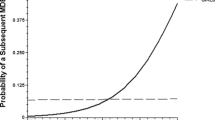Abstract
We report data from the first two years of a longitudinal study of depression, and explanatory style in children. Measures of these variables have been obtained from a group of elementary school children every six months since they were in the third grade. Results show that the boys consistently reported more depressive symptoms than the girls. This was particularly true for symptoms of anhedonia and behavioral disturbance. The boys also showed much more maladaptive explanatory styles than the girls. These results are discussed in light of previous studies of sex differences in children's attributions. Possible reasons for the expected switch in the sex differences in puberty are also discussed.
Similar content being viewed by others
References
Abramson, L. Y., Seligman, M. E. P., Teasdale, J. (1978). Learned helplessness in humans: Critique and reformulation.J. Abnorm. Psychol. 87: 49–74.
Albert, N., and Beck, A. T. (1975). Incidence of depression in early adolescence: A preliminary study.J. Youth Adolesc. 4: 301–307.
Bar-Tal, D. (1978). Attributional analysis of achievement-related behavior.Rev. Educat. Res. 48: 259–271.
Cronbach, L. J. (1951). Coefficient alpha and the internal structure of tests.Psychometrika 16: 205–213.
Dweck, C. S., and Repucci, D. (1973). Learned helplessness and reinforcement responsibility in children.J. Personal. Social Psychol. 25: 109–116.
Eccles (Parsons), J., Adler, T., and Meece, J. L. (1984). Sex differences in achievement: A test of alternate theories.J. Personal. Social Psychol. 46: 26–43.
Eme, R. F. (1979). Sex differences in childhood psychopathology: A review.Psychol. Bull. 86: 574–595.
Frieze, I. H., Fisher, J., Hanusa, B., McHugh, M. C., and Valle, V. A. (1978). Attributions of the causes of success and failure as internal and external barriers to achievement in women. In Sherman, J., and Denmark, F. (eds.),Psychology for Women: Future Directions of Research. Psychological Dimensions, New York.
Frieze, I. H., and Snyder, H. N. (1980). Children's beliefs about the causes of success and failure in school settings.J. Educat. Psychol. 72: 186–196.
Kandel, D. B., and Davies, M. (1986). Adult sequelae of adolescent depressive symptoms.Arch. Gen. Psychiatr. 43: 255–262.
Kashani, J. H., Beck, N. C., Hoeper, E. W., Fallahi, C., Corcoran, C. M., McAllister, J. A., Rosenberg, T. K., and Reid, J. C. (1987). Psychiatric disorders in a community sample of adolescents.Am. J. Psychiatr. 144: 584–589.
Kaslow, N. J., Rehm, L. P., and Siegel, A. W. (1984). Social-cognitive and cognitive correlates of depression in children.J. Abnorm. Psychol. 12: 605–620.
Kaslow, N. J., Tanenbaum, R. L., and Seligman, M. E. P. (1978).The KASTAN: A children's attributional styles questionnaire. Unpublished manuscript, University of Pennsylvania.
Kazdin, A. E. (1981). Assessment techniques for childhood depression.J. Am. Acad. Child Psychiatr. 20: 358–375.
Kovacs, M. (1980). Rating scales to assess depression in school-age children.Acta Paedopsych. 46: 305–315.
Nicholls, J. G. (1975). Causal attributions and other achievement-related cognitions: Effects of task outcome, attainment value, and sex.J. Personal. Social Psychol. 31: 379–389.
Nolen-Hoeksema, S. (1987). Sex differences in unipolar depression: Evidence and theory.Psychol. Bull. 101: 259–282.
Nolen-Hoeksema, S. (1990).Sex Differences in Depression. Stanford University Press, Stanford, CA.
Nolen-Hoeksema, S., Girgus, J. S., and Seligman, M. E. P. (1986). learned helplessness in children: A longitudinal study of depression, achievement, and explantory style.J. Personal. Social Psychol. 51: 435–442.
Parsons, J. E. (1983). Attributions, learned helplessness, and sex differences in achievement.J. Educat. Equity Leader. 3: 19–27.
Pearce, J. (1978). The recognition of depressive disorder in children.J. Roy. Soc. Med. 71: 494–500.
Peterson, C., and Seligman, M. E. P. (1984). Causal explanations as a risk factor for depression: Theory and evidence.Psychol. Rev. 91: 347–374.
Rosen, B. C., & Aneshensel, C. S. (1976). The cahemleon syndrome: A social psycholgoical dimension of the female sex role.Journal of Marriage and the Family. 38: 605–617.
Simmons, R. G., and Blyth, D. A. (1981).Moving into Adolescence: The Impact of Pubertal Change and School Context. Aldine DeGruyter, New York.
Smucker, M. (1982).The Children's Depression Inventory: Norms and psychometric analysis. Unpublished doctoral dissertation, Pennsylvania State University.
Weissman, M. M., and Klerman, G. L. (1977). Sex differences in the epidemiology of depression.Arch. Gen. Psychiatr. 34: 98–111.
Author information
Authors and Affiliations
Additional information
Received Ph.D. from University of Pennsylvania. Research interests are depression and emotion regulation.
Received Ph.D. from New School for Social Research. Research interests are achievement and depression.
Received Ph.D. from University of Pennsylvania. Research interests are depression and explanatory style.
Rights and permissions
About this article
Cite this article
Nolen-Hoeksema, S., Girgus, J.S. & Seligman, M.E.P. Sex differences in depression and explanatory style in children. J Youth Adolescence 20, 233–245 (1991). https://doi.org/10.1007/BF01537610
Issue Date:
DOI: https://doi.org/10.1007/BF01537610




